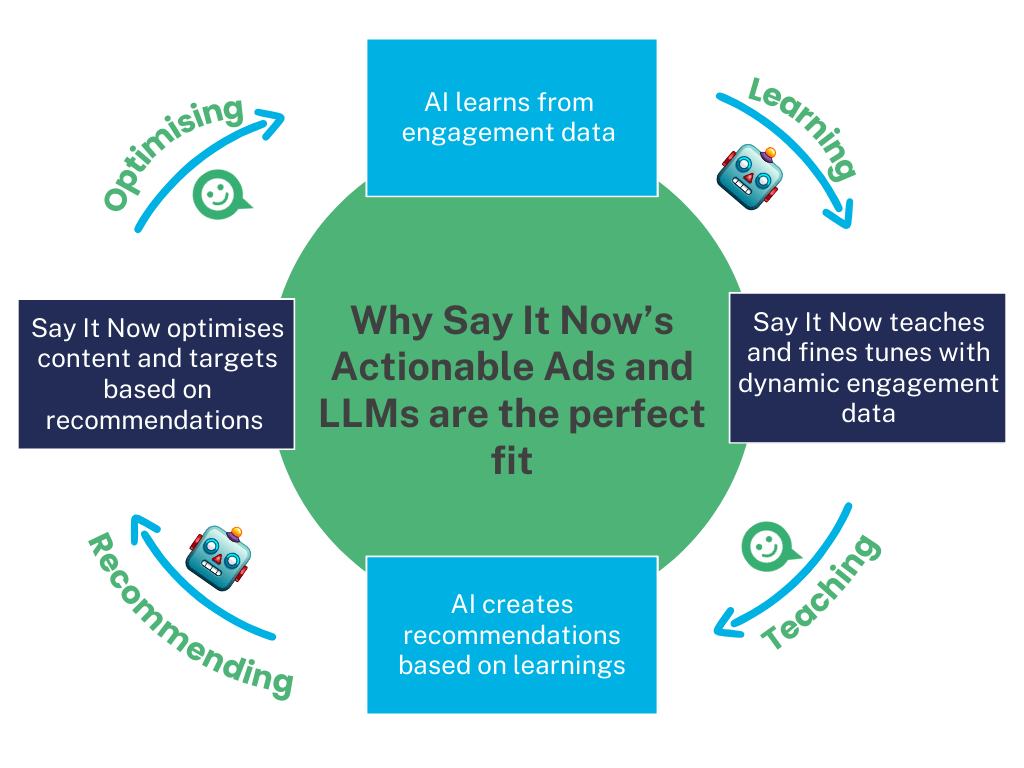Voice Assistants and LLMs: Say It Now’s Clear Vision in a Transforming Landscape
We have had a clear vision on the power of voice since Say It Now’s inception. In our first year of trading, we won The Alexa Cup and a $25k ‘99 Second Pitch Competition’ by articulating our how we saw a voice-first future.
Like many technologies, voice had to journey through the hype cycle from initial overinflated expectations to a slow climb towards a mass-adopted interface delivering unquestionable value to everyday behaviors. According to a recent report by Global Media, smart speakers are now in 60% of UK homes and Alexa saw a 35% bump in YoY usage last year. We’ve previously seen this happen with internet access, mobile use and now it’s the turn of voice. However, this is not just an interface, there is a new intelligence component baked in that makes this more interesting and powerful than previous disruptive technologies.
Let’s explore how.
Voice assistants are morphing from speakers used for a narrow set of tasks into intelligent companions that support our daily endeavors with an unprecedented grasp of natural language understanding and processing. This mirrors the principal method humans engage with each other. Speaking is the most efficient form of communication and one of the principal ways in which we build trusted relationships. We are now in a position where technology is on par with humans and at scale.
Amazon recently announced its intent to incorporate the Large Language Model (LLM) – Anthropic into Alexa, the tech community was abuzz with anticipation. Imagine voice assistants truly understanding context, nuance, and employing a degree of self-awareness, like conversing with an old friend.
“Adopting Anthropic into Alexa’s capabilities is not just an upgrade; it’s an evolution. It will weave the sophistication of understanding user intent, memory, and adaptive learning into voice interactions,” foresees Charlie Cadbury, CEO of Say It Now.
As champions of this revolution, Say It Now has thought deeply about where and how voice can work for the population at large, specifically to benefit advertising. Within the home, we have had broadcast devices for decades in the form of the radio and the television. They can only broadcast advertising messages to you with no chance to engage or respond. As our ‘conversationalist in residence’ once noted:
“Radio and TV advertising are based on post-war ‘command and control’ propaganda techniques, repeating messaging until you comply” – Dr. John Reed
With voice engagement, you have the ability to engage in the discourse, on your terms, easily.
For example, if you are shown a new car you’d like to test drive on a TV ad you can just say “Alexa, open Falcon E5” to book your test drive, all whilst leaning back on your couch.
As technology optimists at Say It Now, we are looking to take friction out of everyday human-computer engagements and the opportunities for voice to do that are abundant.
However, the mechanisms to create, and launch a branded voice experience are hard and not accessible to all. We wanted to democratize the ability to create and measure voice engagement.
Say It Now’s unique, self-developed platform doesn’t merely produce actionable audio ads but also offers a systematic approach to monitor and optimize advertising campaigns with actionable responses.
Moreover, Say It Now has incorporated AI tools to assist each step of the ad production process. From drafting scripts, and managing audio production, to overseeing Skill production, AI has been pivotal in enhancing efficiency and product quality.
“The intrinsic design of our platform is specially devised to meld with AI technology integrations. It’s not just about keeping pace with technological advancements but foreseeing, adapting, and potentially, leading them,” emphasizes Norbert Horvath, Chief Technology Officer of Say It Now.
Horvath continues “Say It Now’s platform is not only extensible but also agnostic, which allows it to seamlessly integrate AI tools to burgeon its current capabilities. This extends into facilitating dynamic conversations that ensure brand safety and assisting in AI-driven campaign planning and optimization. As an adaptable entity, the system will harness any significant advancements in voice AI. It also retains the capability to intertwine with other emerging AI platforms and voice interactive channels.”
According to Voicebot.ai, voice assistant use rose by 11.5% in 2022 and a recent Global Media study shows 60% of UK homes now have a smart speaker, showcasing a burgeoning user base and an enlarging market for intelligent assistants.
Incorporating LLMs like Anthropic/Claude and with new voice assistant platforms emerging – Apple is upgrading Siri, Google is upgrading its assistant, Meta is going to allow you to use your voice to engage with Met.AI and I’d be very surprised if there wasn’t a hardware device from Open AI on the horizon allowing you to build a relationship with their assistant using your voice. Voice is rushing forward fast.
Cadbury goes on to say, “The symbiosis between advanced LLMs and voice assistants will not merely expand but redefine the user experience. It will escalate the usability and adoption of these devices by making them friendlier and more knowledgeable, transforming them from mere tools to intelligent companions and an important arena for compelling conversations between consumers and brands”
Say It Now not only acknowledges, but eagerly embraces this future, intent on continuing to forge interactive, intelligent, and efficient advertising experiences on voice assistant platforms. Regardless of the technological landscape that unfurls, Say It Now is primed to navigate, adapt, and play a meaningful role in how consumers and brands converse, deepening their relationships.

